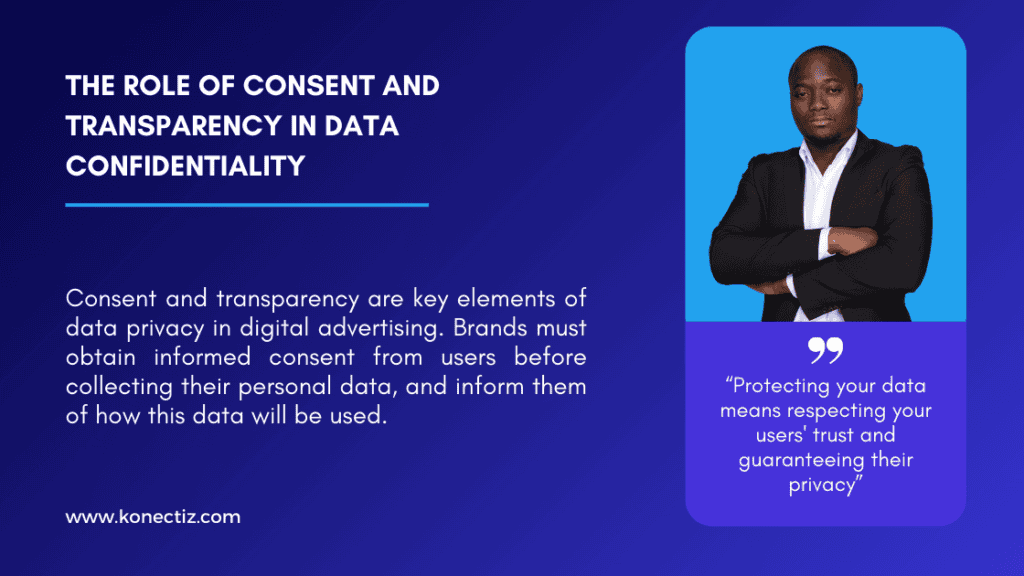Introduction
Data privacy has a major impact on digital advertising strategies.
With the growing importance of personal data and consumer concerns about its use, brands need to rethink their advertising approaches in order to maintain and increase trust.
In this context, it becomes essential to understand the impact of data privacy on digital advertising strategies.
Consumers are increasingly aware of their privacy rights, and want to control how their personal data is used.
Brands need to recognize this evolution and adapt their advertising practices accordingly.
In this article, we’ll explore the ins and outs of the impact of data privacy on digital advertising strategies, and provide practical advice for brands wishing to remain competitive in this new, ever-changing digital landscape.
The impact of regulations on digital advertising
With the adoption of regulations such as the General Data Protection Regulation (GDPR) in Europe and the California Consumer Privacy Act (CCPA) in the United States, brands are required to comply with strict data protection standards.
These regulations give consumers greater control over their personal data and impose severe penalties for non-compliance.
Brands therefore need to pay close attention to these regulations and ensure they are compliant.
This means putting in place processes to gather consumer consent in a transparent way, securing the data collected and implementing appropriate protection measures.
Data privacy laws and regulations
In today’s digital world, data privacy laws and regulations play a key role in how brands collect, process and use consumers’ personal data.
Regulations such as the European Union’s General Data Protection Regulation (GDPR) and the California Consumer Privacy Act (CCPA) have been put in place to protect consumers’ data privacy rights.
The RGPD, for example, requires brands to obtain explicit consent from users before collecting their personal data.
Companies must also inform users of the purpose of data collection and how it will be used.
Failure to comply with these regulations exposes brands to substantial fines and reputational damage.
It is therefore essential for brands to familiarize themselves with the laws and regulations in force in their country or region, and to ensure that they comply with data privacy requirements.
This will help maintain consumer confidence and minimize legal and financial risks.
The impact of data confidentiality on targeting and personalization
Data privacy also has a significant impact on targeting and personalization strategies in digital advertising.
Prior to the introduction of strict regulations, brands could collect and use consumers’ personal data quite freely to fine-tune their advertising to users’ interests and preferences.
However, with growing concerns about data privacy, brands now need to be more cautious about collecting and using consumer data.
This means that targeting and personalization methods need to be more transparent and privacy-friendly.
Brands need to strike a delicate balance between collecting enough data to provide relevant, personalized advertising, while respecting users’ privacy.
This can be achieved by using techniques such as data anonymization, using cohorts of users rather than individual data, or by giving users the ability to control the types of ads they wish to see.
Balancing data privacy and campaign effectiveness
A major challenge facing brands is finding the right balance between data privacy and the effectiveness of their advertising campaigns.
While data privacy is essential to maintaining consumer trust, brands must also be able to deliver relevant and effective advertising.
To achieve this balance, brands can use techniques such as contextual targeting rather than targeting based on personal data.
For example, instead of collecting users’ demographic data, brands can serve ads based on the content of the web page or application the user is on.
Brands may also consider using third-party cookies in a more limited way, focusing more on proprietary cookies that are used only by the brand’s specific site or application.
This reduces the risk of data privacy breaches, while still allowing a degree of advertising personalization.
The role of consent and transparency in data confidentiality

Consent and transparency are key elements of data privacy in digital advertising.
Brands must obtain informed consent from users before collecting their personal data, and inform them of how this data will be used.
Consent must be voluntary, specific and informed.
Users must understand what they are consenting to, and be able to refuse or withdraw their consent at any time.
Brands must also provide clear information on how data will be used, shared and stored.
Transparency is also essential to maintain consumer trust.
Brands need to be open and honest about their data collection and use practices.
This includes disclosing the third-party partners with whom they share data, as well as the specific advertising purposes for which the data is used.
Tools and technologies to ensure data confidentiality in digital advertising
There are many tools and technologies available to help brands ensure data privacy in digital advertising.
Here are just a few examples:
1. Consent management platforms (CMP)
Consent management platforms (CMP) are platforms that enable brands to collect and manage user consent efficiently and in compliance with data privacy regulations.
2. Data anonymization
This technique removes personally identifiable information from the data collected, while retaining its usefulness for analysis or targeted advertising.
3. Data encryption
Encryption of sensitive data ensures that it cannot be read or used by unauthorized persons.
This adds an extra layer of security to protect data confidentiality.
4. Cookie management
Brands can use cookie management solutions to obtain user consent and manage their tracking and personalized advertising preferences.
5. Analysis of anonymous data
Brands can use anonymous data analysis techniques to obtain information and insights into users’ usage habits and preferences, without violating their privacy.
Conclusion
Ultimately, the impact of data privacy on digital advertising strategies is redefining the paradigm of the relationship between brands and consumers.
As regulations tighten and public awareness grows, advertisers are faced with the compelling need to rethink their approaches.
The balance between personalized advertising and respect for privacy rights is becoming the key to consumer trust and loyalty.
By carefully navigating this complex landscape, brands can not only protect data privacy, but also build lasting relationships with their audiences in this ever-changing digital age.





